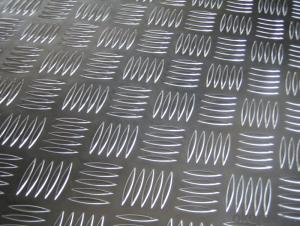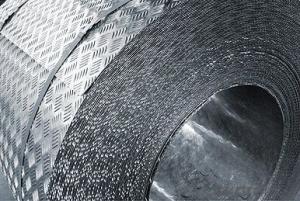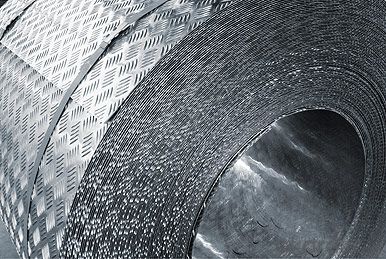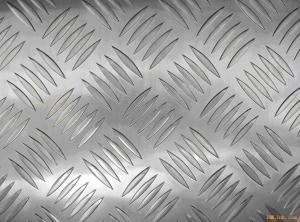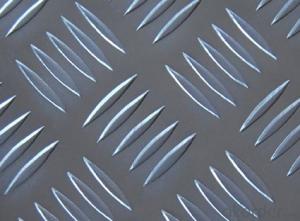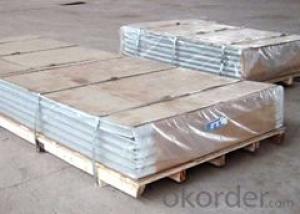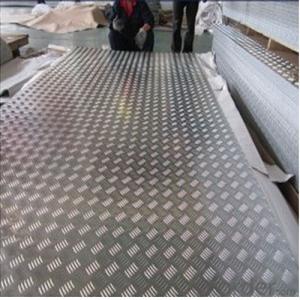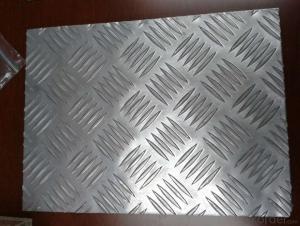Lincane Aluminum Sheets - Aluminium Tread Plate Small Five Bar Pattern
- Loading Port:
- Shanghai
- Payment Terms:
- TT or LC
- Min Order Qty:
- 5 m.t
- Supply Capability:
- 5000 m.t/month
OKorder Service Pledge
OKorder Financial Service
You Might Also Like
We are one of the largest aluminum producer in China, and we also use of aluminum rod, billets, rod, foils, sheet, circles, embossed coil etc.We have produced Aluminum Coils over 10 years, and we have good reputation of the price and quality in China
| Aluminum Coil/Sheet | ||||||||
| Main Specification | ||||||||
| Alloy | AA1xxx (AA1050, AA1060, AA1070, AA1100 etc.) | |||||||
| AA3xxx (AA3003, AA3004, AA3005, AA3105 etc.) | ||||||||
| AA5xxx, AA6XXX (AA5052,AA5083, AA5754, AA6061, AA6062 etc.) | ||||||||
| AA8xxx(AA8011, AA8006 etc.) | ||||||||
| Temper | H14,H16, H18, H22, H24, H26, H32,O/F, T4, T6, T651 | |||||||
| Thickmess | 0.01mm-100mm | |||||||
| Width | 30mm-1700mm | |||||||
| Standard | GB/T 3880-2006/ASTM | |||||||
| Special specification is available on customer's requirement | ||||||||
Description:
Small Five Bars Sheet/Big Five Bars Sheet
Alloy: 1100/1050/1060/3003/3105/5052
Thickness: 0.7-8mm
Width: 100-1500mm
Length: Max 6000mm
standard:GB/T3618-2006
End use: Construction, Decoration, Anti-skid and protection in automobile, Trucks , Steamer construction, etc.
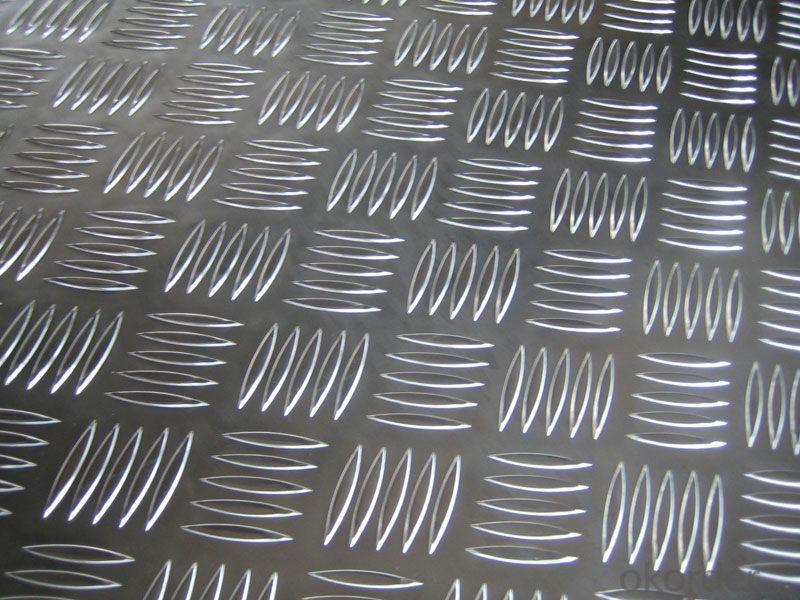
- Q: I am thinking about getting a MacBook Aluminum or a MacBook white. The Aluminum is 2.0 GhZ and the MacBook White is 2.16 GhZ. which should i get? also i am really wondering if you can upgrade the processors in both MacBooks..... Please give me link if you can. THANKS!!
- The aluminum will definitely be faster than the white one assuming those clock speeds are accurate. The 2.16 is an older model with an early Core 2, slower RAM, and a much slower video card. And you cannot swap the CPU in any of Apple's laptops made over the past decade or so.
- Q: What is the cost of aluminum sheets compared to other metals?
- The cost of aluminum sheets can vary in comparison to other metals, depending on various factors like grade, thickness, size, and market conditions. However, in general, aluminum sheets are typically more cost-effective than other metals. This is because aluminum is one of the most abundant elements on Earth, making it more easily accessible and less costly to produce. Furthermore, aluminum has a lower density than many other metals, meaning that less material is required to achieve the same level of strength and durability. This contributes further to its lower cost. On the other hand, metals such as steel or titanium may be pricier due to their scarcity or higher processing expenses. Nevertheless, it's important to note that prices can fluctuate over time due to various economic factors. Therefore, it is always advisable to check the current market prices before making any purchasing decisions.
- Q: This question asks for a comparison between aluminum sheets and other roofing materials in terms of their characteristics and performance.
- <p>Aluminum sheets are lightweight and highly durable, offering excellent resistance to corrosion and weathering. They are energy-efficient, reflecting heat and reducing cooling costs. Compared to materials like asphalt shingles, aluminum is more expensive but lasts longer, with a lifespan of 40-50 years. Unlike clay or concrete tiles, aluminum is less prone to breakage and is easier to install. It also doesn't rot or warp like wood, and it's fire-resistant. However, it can be noisy during rain and is less visually appealing than some other materials, but its modern and sleek appearance can be a design advantage.</p>
- Q: I need to find 3 elements for my science hw tonight. I was wondering if aluminum foil is a pure element. And also I was wondering if anyone had any ideas of what is a pure element (not a compound or an alloy). Thanks!!!!
- I'm pretty sure that the words element and pure element are exchangeable... pure element basically just emphasizes the fact that it is pure.
- Q: I may use the copper or brass for an inlay on a decorative piece of aluminum I'm working on.....
- This Site Might Help You. RE: which has the lower melting temperature....aluminum, copper, or brass...can you list all 3? I may use the copper or brass for an inlay on a decorative piece of aluminum I'm working on.....
- Q: Are aluminum sheets suitable for lightweight structures?
- Indeed, aluminum sheets prove to be a fitting choice when it comes to lightweight structures. Renowned for its low density and impressive strength-to-weight ratio, aluminum emerges as an optimal material for applications requiring reduced weight. Industries such as aerospace, automotive, and construction frequently rely on aluminum sheets due to their exceptional corrosion resistance, durability, and malleability. These properties facilitate effortless fabrication and installation. Moreover, the versatility of aluminum sheets extends to their effortless joining through diverse welding and adhesive methods, thereby bolstering their aptness for lightweight structures.
- Q: Are aluminum sheets suitable for aerospace applications?
- Yes, aluminum sheets are highly suitable for aerospace applications. Aluminum is widely used in the aerospace industry due to its excellent combination of strength, lightweight properties, and corrosion resistance. Its high strength-to-weight ratio makes it an ideal choice for constructing aircraft structures, including fuselages, wings, and other critical components. Aluminum sheets also offer good formability, allowing for complex shapes to be easily manufactured. Additionally, aluminum has good thermal conductivity, which is beneficial for heat dissipation in aerospace applications. Overall, aluminum sheets meet the stringent requirements of the aerospace industry and are extensively utilized in the construction of modern aircraft.
- Q: Can aluminum sheets be used for flooring?
- Indeed, flooring can utilize aluminum sheets. Lightweight and sturdy, aluminum proves resistant to corrosion, rendering it an appropriate option for a range of flooring uses. Notably, aluminum sheets frequently find employment in industrial, commercial, and residential settings, encompassing warehouses, garages, kitchens, and outdoor areas. These sheets offer commendable strength, effortless installation, and minimal upkeep. Furthermore, aluminum flooring imparts a polished and contemporary aesthetic to any given space. Nevertheless, prudent consideration of factors like thickness, finish, and the unique demands of the flooring project becomes imperative prior to settling on aluminum sheets.
- Q: I think I remember that this is true of aluminum foil. When it's charged, it'll push away from itself, I know. Why do magnets have seemingly no effect?
- Aluminum is a non-ferrous metal. Ferrous metals contain Iron which is magnetic. When aluminum has a charge applied to it, it acts like any conductor would, the charge has magnetic properties. the aluminum is still not magnetic, but it acts like a magnet due to the charge.
- Q: Thickness of Aluminum Foil A rectangular sheet ofaluminum foil is 50 centimeters long and 20 centimeterswide, and weighs 5.4 grams. Find the thicknessof the aluminum foil in centimeters
- density Aluminum 2700 kg/m? Volume = 0.5 x 0.2 x d = 0.1d m? where d is thickness 5.4 g = 0.0054 kg 0.0054 kg / 2700 kg/m? = 2.0e-6 m? 2.0e-6 m? = 0.1d m? d = 2.0 e-5 m or 20 ?m or 0.02 mm or 0.002 cm .
Send your message to us
Lincane Aluminum Sheets - Aluminium Tread Plate Small Five Bar Pattern
- Loading Port:
- Shanghai
- Payment Terms:
- TT or LC
- Min Order Qty:
- 5 m.t
- Supply Capability:
- 5000 m.t/month
OKorder Service Pledge
OKorder Financial Service
Similar products
Hot products
Hot Searches
Related keywords
